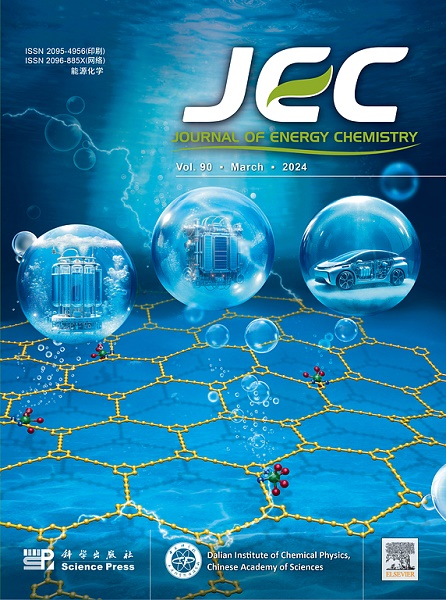Carbon-encapsulated Li2NiO2 lithium compensator: decoding failure mechanisms and enabling high-performance pouch cells
IF 13.1
1区 化学
Q1 Energy
引用次数: 0
Abstract
Li2NiO2 has emerged as a promising cathode pre-lithiation additive capable of substantially enhancing the energy density and cycling durability of next-generation lithium-ion batteries. However, its practical deployment is hindered by intrinsic surface structural instability under ambient conditions. Although prior studies have reported residual alkali formation on Li2NiO2 surfaces and proposed coating strategies, critical knowledge gaps persist regarding the temporal evolution of alkali byproducts and industrially viable modification approaches. Through multiscale in situ characterizations combining X-ray diffraction (XRD), Raman spectroscopy, and X-ray photoelectron spectroscopy (XPS), we reveal a stratified residual alkali architecture: the inner layer predominantly comprises Li2CO3 while the outer layer is dominated by LiOH, despite minimal bulk structural alterations. Leveraging these insights, we developed a facile carbon-coating strategy enabling scalable synthesis of hundred-gram batches. The conformal carbon layer effectively mitigates structural degradation and suppresses alkali formation, facilitating the integration of high-content pre-lithiation additives. LiFePO4||graphite pouch cells incorporating 2.5% modified Li2NiO2 demonstrate enhanced specific capacity with exceptional stability—exhibiting negligible energy decay (99.58% retention) over 500 cycles at 0.5P and maintaining 81.15% energy retention under aggressive 4P/4P cycling conditions over 1000 cycles. Remarkably, pouch cells with 8% additive loading achieve zero energy density decay after 1000 cycles at 4P/4P. This work provides a practical and scalable solution for advancing high-energy–density lithium-ion battery technologies.

碳封装Li2NiO2锂补偿器:解码失效机制和实现高性能袋电池
Li2NiO2已经成为一种很有前途的阴极预锂化添加剂,能够大大提高下一代锂离子电池的能量密度和循环耐久性。然而,它的实际应用受到环境条件下表面结构固有不稳定性的阻碍。尽管先前的研究已经报道了在Li2NiO2表面上残留的碱形成并提出了涂层策略,但关于碱副产物的时间演变和工业上可行的改性方法的关键知识差距仍然存在。通过结合x射线衍射(XRD)、拉曼光谱(Raman spectroscopy)和x射线光电子能谱(XPS)的多尺度原位表征,我们揭示了一种分层的残碱结构:尽管体积结构变化很小,但内层主要由Li2CO3组成,外层主要由LiOH组成。利用这些见解,我们开发了一种简单的碳涂层策略,使百克批次的可扩展合成成为可能。适形碳层有效地减缓了结构降解,抑制了碱的形成,有利于高含量的预锂化添加剂的整合。含有2.5%改性Li2NiO2的LiFePO4||石墨袋电池显示出增强的比容量和卓越的稳定性-在0.5P下500次循环中表现出可忽略的能量衰减(99.58%的保留率),在4P/4P循环条件下超过1000次循环保持81.15%的能量保留率。值得注意的是,当负荷量为8%时,在4P/4P下循环1000次后,袋状电池的能量密度衰减为零。这项工作为推进高能量密度锂离子电池技术提供了一种实用且可扩展的解决方案。
本文章由计算机程序翻译,如有差异,请以英文原文为准。
求助全文
约1分钟内获得全文
求助全文
来源期刊

Journal of Energy Chemistry
CHEMISTRY, APPLIED-CHEMISTRY, PHYSICAL
CiteScore
19.10
自引率
8.40%
发文量
3631
审稿时长
15 days
期刊介绍:
The Journal of Energy Chemistry, the official publication of Science Press and the Dalian Institute of Chemical Physics, Chinese Academy of Sciences, serves as a platform for reporting creative research and innovative applications in energy chemistry. It mainly reports on creative researches and innovative applications of chemical conversions of fossil energy, carbon dioxide, electrochemical energy and hydrogen energy, as well as the conversions of biomass and solar energy related with chemical issues to promote academic exchanges in the field of energy chemistry and to accelerate the exploration, research and development of energy science and technologies.
This journal focuses on original research papers covering various topics within energy chemistry worldwide, including:
Optimized utilization of fossil energy
Hydrogen energy
Conversion and storage of electrochemical energy
Capture, storage, and chemical conversion of carbon dioxide
Materials and nanotechnologies for energy conversion and storage
Chemistry in biomass conversion
Chemistry in the utilization of solar energy
 求助内容:
求助内容: 应助结果提醒方式:
应助结果提醒方式:


